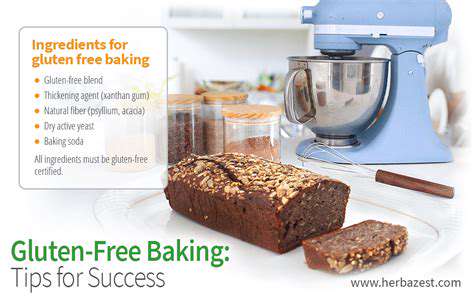Gluten Free Baking Essentials: Flour Blends and More
Navigating Gluten-Free Baking Techniques

Understanding Gluten-Free Flours
Gluten-free baking often requires a different approach than traditional baking, primarily due to the absence of gluten, the protein complex responsible for the structure and elasticity of bread. Understanding the various gluten-free flours available is crucial for achieving desired textures and results. Different flours, such as rice flour, tapioca flour, and potato starch, each possess unique characteristics, affecting the final product's moisture content, density, and overall mouthfeel. Choosing the right combination of flours is key to achieving a satisfying gluten-free baked good.
Experimentation with different gluten-free flours is essential for success in gluten-free baking. Each flour type has its own strengths and weaknesses, and the best results come from understanding how they interact with other ingredients. This experimentation allows bakers to develop a personalized approach to gluten-free baking, tailoring recipes to their specific preferences and desired outcomes. It's a journey of discovery, where the key to success lies in understanding the nuances of each flour.
Mastering Gluten-Free Binding Agents
Gluten-free baking relies heavily on alternative binding agents to achieve the desired structure and texture. These agents, such as xanthan gum, guar gum, and psyllium husk, play a vital role in mimicking the role of gluten in traditional baking. Understanding the function of these agents and their optimal usage levels is essential for creating gluten-free baked goods that hold their shape and have a satisfying chewiness. Carefully following recipe instructions and adjusting ingredient amounts based on the specific type of gluten-free flour used is critical for success.
Using the right amount of binding agents is paramount in gluten-free baking. Too little, and the baked goods may fall apart; too much, and they might become gummy or tough. Properly incorporating these agents is essential to achieving a balance between structure and texture in gluten-free products. This process often requires careful attention to detail and a willingness to experiment to find the perfect balance.
Innovative Techniques for Gluten-Free Baking
Beyond understanding flours and binding agents, successful gluten-free baking often involves innovative techniques to compensate for the lack of gluten. Techniques like incorporating specific liquids, such as applesauce or mashed bananas, can add moisture and enhance structure. Employing techniques like layering or folding ingredients gently can help to create a more uniform and visually appealing product. The key is to be adaptable and creative in your approach, finding ways to work with the unique characteristics of gluten-free ingredients.
Adapting traditional baking techniques to the gluten-free environment is key to success. This often requires a shift in mindset, moving from a reliance on gluten's structural properties to exploring alternative methods for achieving desired results. This approach allows for a more personalized and creative baking experience, leading to delicious and enjoyable gluten-free creations.
Using specialized equipment, such as high-speed mixers or stand mixers, can also enhance the gluten-free baking experience. These tools can help to incorporate ingredients more effectively, leading to better texture and structure. Careful attention to temperature control during the baking process is crucial for achieving optimal results, as it can significantly impact the final product's texture and appearance.
Breakfast is crucial for kickstarting your metabolism and providing sustained energy throughout the morning. However, it's easy to overindulge, especially with tempting breakfast pastries or sugary cereals. Portion control for breakfast involves mindful choices and mindful eating. Instead of loading up on a huge plate of pancakes or a massive bowl of cereal, opt for smaller portions of whole-grain options, lean proteins like eggs or Greek yogurt, and healthy fats like avocado. This balanced approach ensures you're energized without overeating.

- Smart Food Storage: Keep Your Groceries Fresh Longer
- Simple Pasta Dishes: Weeknight Wonders
- Mastering French Sauces: A Guide to Classic Techniques
- Kitchen Organization for Small Spaces: Maximizing Every Inch
- Sustainable Grocery Shopping: Eco Friendly Choices
- Cooking with Electric Skillet: Versatile Cooking
- Kitchen Appliances for Healthy Cooking: Smart Choices
- Classic American Meatloaf: The Ultimate Comfort Food
- Sourdough Troubleshooting: Common Issues and Solutions
- Simple Pork Recipes: Versatile and Delicious
- Discovering Ethiopian Wats: Flavorful Stews
- Understanding Food Safety: Preventing Illness